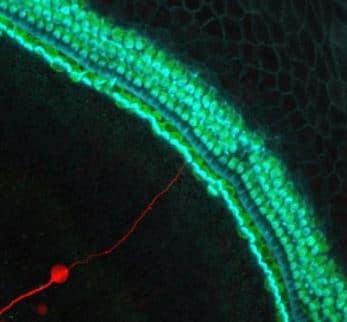Hearing loss is a serious global morbidity that affects 360 million people worldwide, according to the World Health Organization. At a basic level, hearing loss of adult onset can be a source of social isolation and even depression for individuals coping with its ill-effects. Even more consequential, children with hearing loss are at risk of diminished language and cognitive development as a result of their reduced exposure to sound. Thus, for anyone afflicted with the condition, hearing loss represents a substantial burden for patients, caregivers, schools, employers and the healthcare system. For these reasons, scientists have chased a potential cure or long term treatment for damaged inner ear hair cells.
Recent research holds promise in this area, as stem cells of the cochlea in one laboratory were converted to auditory neurons. This scientific feat could reverse sensorineural hearing loss, but the conversion process, according to one recent study conducted at Rutgers University, has a risky downside: these stem cells can divide too quickly, posing a cancer risk.
Hearing Loss, Stem Cells and Caution
According to a November 7 Science Daily report, when stem cells get converted to auditory cells too quickly abnormal cellular growth can occur. “It’s a cautionary tale,” explained senior study investigator Kevin Kwan, Ph.D., assistant professor in the department of cell biology and neuroscience in the School of Arts and Sciences at Rutgers.
“People say, ‘we’ll just put stem cells in and we’re going to replace lost neurons.’ We’re saying that ‘yes, we can make neurons,’ but you have other side effects that are unanticipated, such as increased proliferation of stem cells. So, this will guide us toward a better strategy for cell replacement therapies.”
In the current study, cited in that November 7 Science Daily article, the scientists over-expressed a gene called NEUROG1 to turn inner ear stem cells into auditory neurons. “Using an immortalized multipotent otic progenitor (iMOP) cell line that can self-renew and differentiate into otic neurons, NEUROG1 was enriched at the promoter of cyclin-dependent kinase 2 (Cdk2) and neurogenic differentiation 1 (NeuroD1) genes,” the authors wrote. “Changes in H3K9ac and H3K9me3 deposition at the Cdk2 and NeuroD1 promoters suggested epigenetic regulation during iMOP proliferation and differentiation. In self-renewing iMOP cells, overexpression of NEUROG1 increased CDK2 to drive proliferation, while knockdown of NEUROG1 decreased CDK2 and reduced proliferation. In iMOP-derived neurons, over-expression of NEUROG1 accelerated the acquisition of neuronal morphology, while knockdown of NEUROG1 prevented differentiation.”
Further Study Needed
According to Dr. Kwan the overexpression of NEUROG1 “leads to increased cell division, and NEUROG1 is used in other stem cells to make other types of neurons. Scientists in other fields should be aware that when using this factor they’ll probably also increase cell proliferation.”
Interestingly, the Rutgers team also discovered that chromatin—DNA studded with histone proteins—influences how NEUROG1 functions. Changes in chromatin may help reduce unwanted stem cell proliferation and can be achieved by adding drugs to experimental cultures. “Ideally, we would change the chromatin state before we start overexpressing NEUROG1 and prevent unwanted stem cell proliferation,” Dr. Kwan concluded.
*Image courtesy SD via Rutgers








I am pleased to note that the other side of stem cell consequences have been studied and caution indicated . Stimulation of any implanted growth has its unintended consequences.
The other point that I see harped on is “depression”. Hearing loss does not lead to depression, but does cause “melancholic ” moods that leave the patient in isolation and reduced will and energy to participate in discussion/conversations. Depression is a pathological consequence that primarily occurs due to excessive drug intakes (medicinal or otherwise), that play havoc with certain neurotransmitter sequences. It needs clinical attention.
This is amazing progress made by scientists and researchers in the hearing loss field! I have worn hearing aids for over 35 years and since 2014, I’ve worn cochlear implants. Before I had the implants done, I asked my ENT surgeon if my genetic sensorineural hearing loss could ever be corrected by corrective surgery of some kind, and I was told that it probably wouldn’t happen in my lifetime (I am now 61). The fact that progress of stem cells being converted into auditory neurons has already been accomplished is extraordinary to me, and I truly admire and praise these scientists and researchers in their accomplishments! Perhaps it won’t be too far in the future when these stem cells will be converted less quickly, preventing cancer from developing. What tremendous possibilities for infants born with hearing loss or deafness and for those who have lived many years with a hearing loss! Kudos these wonderful people!